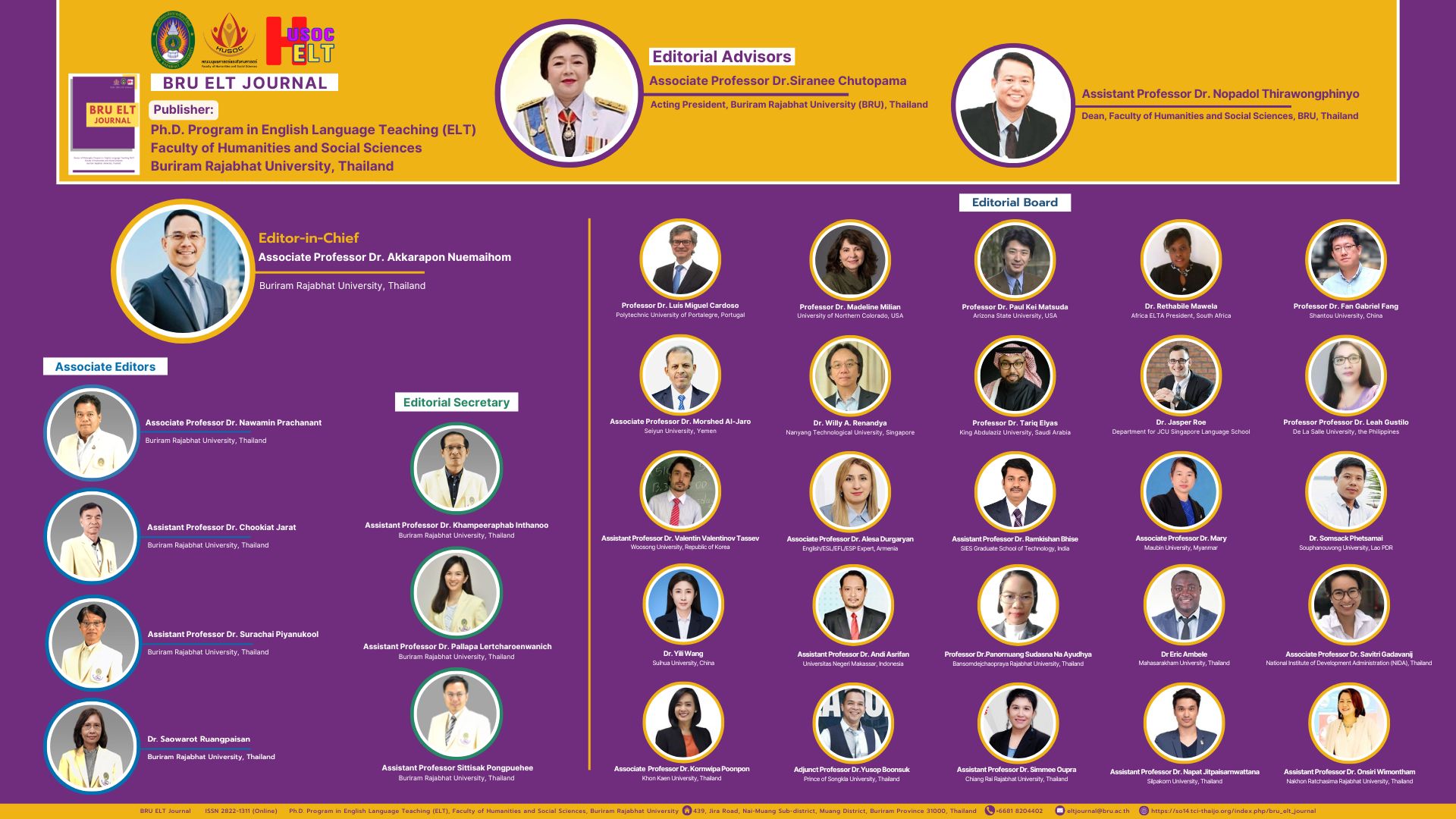Move Analysis of the ‘Discussion Section’ of English Specialization Ph.D. Theses
DOI:
https://doi.org/10.14456/bej.2023.2Keywords:
move analysis, discussion section, English specialization, Ph.D. thesesAbstract
The present research aimed to conduct a move analysis on theses of English specialization students at Ph.D. level in Myanmar and to find significant differences in structures of their ‘Discussion sections’ according to the basic moves and steps in the theses of applied linguistics and English literature domains. Moreover, it also aimed to explore the distribution of ‘Obligatory’, ‘Conventional’, and ‘Optional’ moves and steps. To this aim, 48 theses were selected to be analysed in this research. The Move analysis model proposed by (Yang & Allison, 2003) which was specifically used in applied linguistics and English literature domain was employed in this research. Moreover, each move was justified and classified in terms of the distribution of ‘Obligatory’, ‘Conventional’, and ‘Optional’ moves and steps. According to the findings, statistically significant differences were found in the distribution of moves and steps between applied linguistics and English literature domains. The distribution of ‘Obligatory’, ‘Conventional’, and ‘Optional’ moves and steps was also found varied. It was indicated in phase 1 that Move 2 (Reporting results) was the most frequent as EFL thesis writers tend to report their results in ‘Discussion sections’ significantly. However, Move 5 (Summarizing the study) was found least frequently in both domains. Moreover, the English literature writers indicated background information in the ‘Discussion section’ significantly. This shows that literature writers are more maintained to discuss the background information than writers of applied linguistics. This may be due to the writers’ need to meet the cognitive claims of ‘Discussion sections’ and to have the accurate skills for academic writing styles. In phase 2, Move 2 (Reporting results) was classified as obligatory in both domains although the other six moves were less frequent and were conventional. It was noticed that authors used rhetoric to make claims about their findings which go beyond the data. These results can be used effectively in courses of EFL to increase students’ awareness and avoid them from overstating or understating certain basic parts of the ‘Discussion sections’ in theses.
References
Amnuai, W., & Wannaruk, A. (2013). Investigating move structure of English applied linguistics research article discussions published in international and Thai journals. English Language Teaching, 6(2), 1-13.
Atai, M. R., & Falah, S. (2005). A contrastive genre analysis of result and ‘Discussion sections’ of applied linguistic research articles written by native and non-native English speakers with respect to evaluated entities and ascribed values. http://www.paaljapan.org/resources/proceedings/ PAAL10/ pdfs /atai. pdf (accessed 15/7/2019)
Basturkmen, H. (2012). Languages for specific purposes curriculum creation and implementation in Australasia and Europe. The Modern Language Journal, 96, 59-70.
Brett, P. (1994). A genre analysis of the results section of sociology articles. English for Specific Purposes, 13(1), 47-59.
Chen, T.-Y., & Kuo, C.-H. (2012). A genre-based analysis of the information structure of master's theses in applied linguistics. The Asian ESP Journal, 8(1), 24-52.
Docherty, M., & Smith, R. (1999). The case for structuring the discussion of scientific papers: Much the same as that for structuring abstracts. BMJ: British Medical Journal, 318(7193), 1224-1225.
Dudley-Evans, T. (1994). Variations in the discourse patterns favoured by different disciplines and their pedagogical implications. Academic listening: Research perspectives, 146-158.
Holmes, R. (1997). Genre Analysis, and the Social Sciences: An Investigation of the Structure of RA ‘Discussion sections’ in Three Disciplines. English for Specific Purposes, 16(4), 321-327
Nadoushan, M. (2012, January). A structural move analysis of discussion sub-genre in applied linguistics. Dacoromania, 17(2), 199-212.
Pojanapunya, P., & Watson, R. (2011). Relevance of findings in results to ‘Discussion section’s in applied linguistics research. English for Specific Purposes, 22(4), 365-385.
Posteguillo, S. (1999). The schematic structure of computer science research articles. English for Specific Purposes, 18(2), 139- 160.
Rasmeenin, C. (2006). A structural move analysis of MA thesis ‘Discussion sections’ in applied linguistics, Unpublished MA thesis, Mahidol University, Thailand. http://mulinet11.li.mahidol.ac.th/thesis/2549/cd389/4536492.pdf (accessed 05/7/2019).
Sereebenjapol, P. (2003). An analysis of the errors in English which graduate science students make in the ‘Discussion section’ of their thesis. Unpublished MA thesis. Mahidol University, Thailand.
Swales, J. (1990). Discourse analysis in professional contexts. Annual Review of Applied Linguistics, 11, 103‐114.
Swales, J. M. (2004). The manuscript version of chapter seven of research genres: Explorations and application. Cambridge: Cambridge university press.
Swales, J.M., & Feak, C.B. (2004). Academic writing for graduate students: Essential tasks and skills. Ann Arbor, MI, USA: University of Michigan press.
Thetela, P. (1997). Evaluated entities and parameters of value in academic research articles. English for Specific Purposes, 16(2), 101-118.
Weissberg, R., & Buker, S. (1990). Writing up research. Englewood Cliffs, NJ: Prentice Hall. http://www.uefap.com/materials/history/wur.pdf (accessed 15/7/2019).
Yang, R. Y., & Allison, D. (2003). Research articles in applied linguistics: Moving from results to conclusions. English for Specific Purposes, 22(4), 365‐385.
Zekrati, S. (2015). A Move analysis of ‘discussion section’ of medical articles. Taiwan International ESP Journal, 7(1), 38-50.






